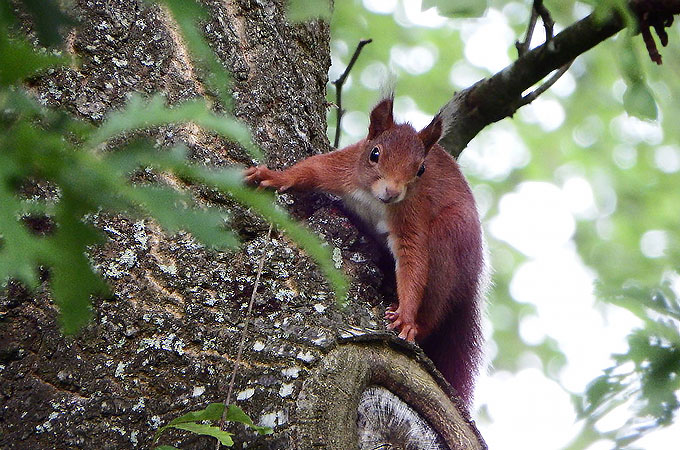Mammals
26 species of mammal have been recorded at Treborth, as follows:
- Red Squirrel (Sciurus vulgaris)– Red squirrels were first discovered in the gardens having crossed from Anglesey in Septemper 1976, but then unrecorded until 2009. There is evidence that they have bred in the gardens - and in 2013/14 we obtained some lovely pictures of a lactating female in the woodland. There have been some student projects focussed upon hair tubes as a means of monitoring red squirrel distribution in the garden and also investigating what types of disease risk squirrels may face from other rodents. With such geographical proximity to Anglesey, it is imperative that the gardens are kept grey squirrel free. The new EU funded Life 14 project, Red Squirrels United will give us a three year window within which to try and eradicate grey squirrels from Bangor.
- Grey Squirrel (S. carolinensis) – strong increase in population between 1980 and 2000, then subject to intense cull (2006 onwards) and now scarce
- Bank Vole (Myodes glareolus) – common in all woodland areas
- Field Vole (Microtus agrestis) – common in the semi natural grassland areas
- Wood Mouse (Apodemus sylvaticus) – abundant in all wooded areas and in parkland
- House Mouse (Mus domesticus) – recorded in small numbers around buildings
- Common Rat (Rattus norvegicus) – present in all areas, numbers not known; probably subject to fluctuations.
- Rabbit (Oryctolagus cuniculus) – generally common, some years abundant.
- Brown Hare (Lepus europaeus) – scarce; not recently reported
- Hedgehog (Erinaceus europaeus) – a declining species, once common but recently only a handful of sightings.
- Mole (Talpa europaea) – common; subject to intermittent control
- Common Shrew (Sorex araneus) – common in all areas
- Noctule Bat (Nyctalus noctula) – regularly flights over the Garden area
- Common Pipistrelle (Pipistrellus pipistrellus) – status uncertain (due to confusion with next species); several undoubted records
- Soprano Pipistrelle (P.pygmaeus) – status uncertain due to confusion with previous species but likely to be the commoner of the two Pipistrelles and positively recorded widely and commonly in the main Garden area. Formerly summered in the roof of the main building.
- Brown long-eared Bat (Plecotus auritus) – a few records in main area of parkland
- Fox (Vulpes vulpes) – widely present but not in large numbers
- Badger (Meles meles) – status uncertain – occasionally reported by various members of the public but not substantiated
- Otter (Lutra lutra) – increasingly recorded along Menai Strait in last 5-10 years; evidence of presence along Strait-side cliffs (scats/food remains)
- Stoat (Mustela erminea) – reasonable numbers; most records relate to individuals observed in and around meadow plots in parkland area
- Weasel (M. nivalis) – as for previous species
- Polecat (M.putorius) – irregularly recorded; at least 5 individuals live trapped 300 metres south of the botanic garden as part of a research project in c. 2005 and some casualties along Treborth Road 2000-2010.
- Feral Ferret (M. furo) – a handful of sightings in the 1990s
- American Mink (M. vison) – a handful of records along the Menai Strait
- Bottle-nosed Dolphin (Tursiops truncatus) – a handful of records over the last 40 years in the Swellies and in Strait east of the Suspension Bridge.
- Harbour Porpoise (Phocoena phocoena) – as above.



